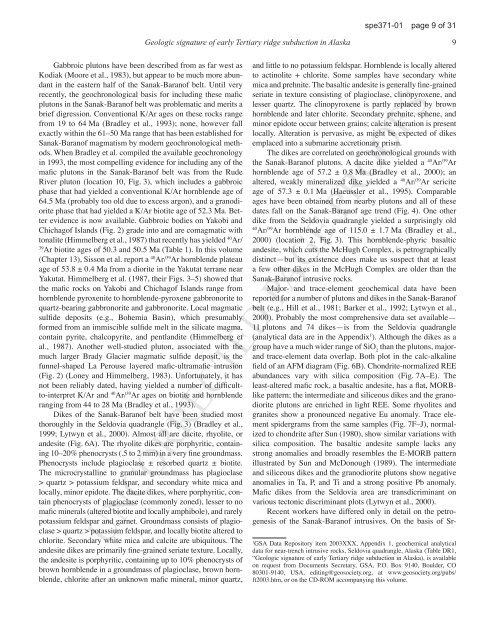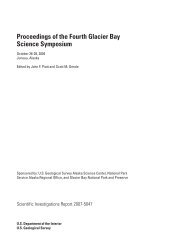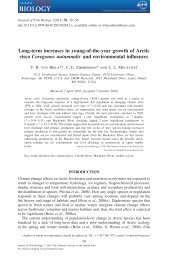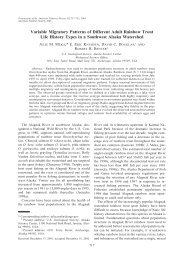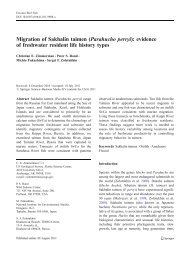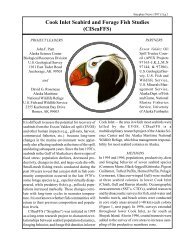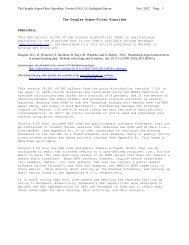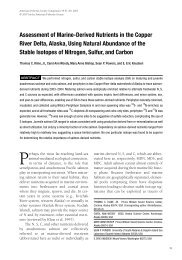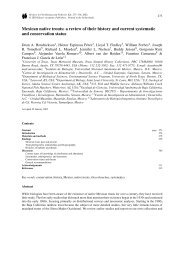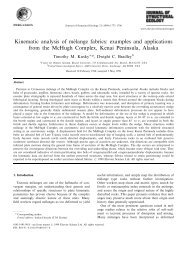UNCORRECTED PAGE PROOFS - USGS Alaska Science Center
UNCORRECTED PAGE PROOFS - USGS Alaska Science Center
UNCORRECTED PAGE PROOFS - USGS Alaska Science Center
Create successful ePaper yourself
Turn your PDF publications into a flip-book with our unique Google optimized e-Paper software.
spe371-01 page 9 of 31<br />
Geologic signature of early Tertiary ridge subduction in <strong>Alaska</strong> 9<br />
Gabbroic plutons have been described from as far west as<br />
Kodiak (Moore et al., 1983), but appear to be much more abundant<br />
in the eastern half of the Sanak-Baranof belt. Until very<br />
recently, the geochronological basis for including these maÞc<br />
plutons in the Sanak-Baranof belt was problematic and merits a<br />
brief digression. Conventional K/Ar ages on these rocks range<br />
from 19 to 64 Ma (Bradley et al., 1993); none, however fall<br />
exactly within the 61–50 Ma range that has been established for<br />
Sanak-Baranof magmatism by modern geochronological methods.<br />
When Bradley et al. compiled the available geochronology<br />
in 1993, the most compelling evidence for including any of the<br />
maÞc plutons in the Sanak-Baranof belt was from the Rude<br />
River pluton (location 10, Fig. 3), which includes a gabbroic<br />
phase that had yielded a conventional K/Ar hornblende age of<br />
64.5 Ma (probably too old due to excess argon), and a granodiorite<br />
phase that had yielded a K/Ar biotite age of 52.3 Ma. Better<br />
evidence is now available. Gabbroic bodies on Yakobi and<br />
Chichagof Islands (Fig. 2) grade into and are comagmatic with<br />
tonalite (Himmelberg et al., 1987) that recently has yielded 40 Ar/<br />
39<br />
Ar biotite ages of 50.3 and 50.5 Ma (Table 1). In this volume<br />
(Chapter 13), Sisson et al. report a 40 Ar/ 39 Ar hornblende plateau<br />
age of 53.8 ± 0.4 Ma from a diorite in the Yakutat terrane near<br />
Yakutat. Himmelberg et al. (1987, their Figs. 3–5) showed that<br />
the maÞc rocks on Yakobi and Chichagof Islands range from<br />
hornblende pyroxenite to hornblende-pyroxene gabbronorite to<br />
quartz-bearing gabbronorite and gabbronorite. Local magmatic<br />
sulÞde deposits (e.g., Bohemia Basin), which presumably<br />
formed from an immiscible sulÞde melt in the silicate magma,<br />
contain pyrite, chalcopyrite, and pentlandite (Himmelberg et<br />
al., 1987). Another well-studied pluton, associated with the<br />
much larger Brady Glacier magmatic sulÞde deposit, is the<br />
funnel-shaped La Perouse layered maÞc-ultramaÞc intrusion<br />
(Fig. 2) (Loney and Himmelberg, 1983). Unfortunately, it has<br />
not been reliably dated, having yielded a number of difÞcultto-interpret<br />
K/Ar and 40 Ar/ 39 Ar ages on biotite and hornblende<br />
ranging from 44 to 28 Ma (Bradley et al., 1993).<br />
Dikes of the Sanak-Baranof belt have been studied most<br />
thoroughly in the Seldovia quadrangle (Fig. 3) (Bradley et al.,<br />
1999; Lytwyn et al., 2000). Almost all are dacite, rhyolite, or<br />
andesite (Fig. 6A). The rhyolite dikes are porphyritic, containing<br />
10–20% phenocrysts (.5 to 2 mm) in a very Þne groundmass.<br />
Phenocrysts include plagioclase ± resorbed quartz ± biotite.<br />
The microcrystalline to granular groundmass has plagioclase<br />
> quartz > potassium feldspar, and secondary white mica and<br />
locally, minor epidote. The dacite dikes, where porphyritic, contain<br />
phenocrysts of plagioclase (commonly zoned), lesser to no<br />
maÞc minerals (altered biotite and locally amphibole), and rarely<br />
potassium feldspar and garnet. Groundmass consists of plagioclase<br />
> quartz > potassium feldspar, and locally biotite altered to<br />
chlorite. Secondary white mica and calcite are ubiquitous. The<br />
andesite dikes are primarily Þne-grained seriate texture. Locally,<br />
the andesite is porphyritic, containing up to 10% phenocrysts of<br />
brown hornblende in a groundmass of plagioclase, brown hornblende,<br />
chlorite after an unknown maÞc mineral, minor quartz,<br />
and little to no potassium feldspar. Hornblende is locally altered<br />
to actinolite + chlorite. Some samples have secondary white<br />
mica and prehnite. The basaltic andesite is generally Þne-grained<br />
seriate in texture consisting of plagioclase, clinopyroxene, and<br />
lesser quartz. The clinopyroxene is partly replaced by brown<br />
hornblende and later chlorite. Secondary prehnite, sphene, and<br />
minor epidote occur between grains; calcite alteration is present<br />
locally. Alteration is pervasive, as might be expected of dikes<br />
emplaced into a submarine accretionary prism.<br />
The dikes are correlated on geochronological grounds with<br />
the Sanak-Baranof plutons. A dacite dike yielded a 40 Ar/ 39 Ar<br />
hornblende age of 57.2 ± 0.8 Ma (Bradley et al., 2000); an<br />
altered, weakly mineralized dike yielded a 40 Ar/ 39 Ar sericite<br />
age of 57.3 ± 0.1 Ma (Haeussler et al., 1995). Comparable<br />
ages have been obtained from nearby plutons and all of these<br />
dates fall on the Sanak-Baranof age trend (Fig. 4). One other<br />
dike from the Seldovia quadrangle yielded a surprisingly old<br />
40<br />
Ar/ 39 Ar hornblende age of 115.0 ± 1.7 Ma (Bradley et al.,<br />
2000) (location 2, Fig. 3). This hornblende-phyric basaltic<br />
andesite, which cuts the McHugh Complex, is petrographically<br />
distinct—but its existence does make us suspect that at least<br />
a few other dikes in the McHugh Complex are older than the<br />
Sanak-Baranof intrusive rocks.<br />
Major- and trace-element geochemical data have been<br />
reported for a number of plutons and dikes in the Sanak-Baranof<br />
belt (e.g., Hill et al., 1981; Barker et al., 1992; Lytwyn et al.,<br />
2000). Probably the most comprehensive data set available—<br />
11 plutons and 74 dikes—is from the Seldovia quadrangle<br />
(analytical data are in the Appendix 1 ). Although the dikes as a<br />
group have a much wider range of SiO 2<br />
than the plutons, majorand<br />
trace-element data overlap. Both plot in the calc-alkaline<br />
Þeld of an AFM diagram (Fig. 6B). Chondrite-normalized REE<br />
abundances vary with silica composition (Fig. 7A–E). The<br />
least-altered maÞc rock, a basaltic andesite, has a ßat, MORBlike<br />
pattern; the intermediate and siliceous dikes and the granodiorite<br />
plutons are enriched in light REE. Some rhyolites and<br />
granites show a pronounced negative Eu anomaly. Trace element<br />
spidergrams from the same samples (Fig. 7F–J), normalized<br />
to chondrite after Sun (1980), show similar variations with<br />
silica composition. The basaltic andesite sample lacks any<br />
strong anomalies and broadly resembles the E-MORB pattern<br />
illustrated by Sun and McDonough (1989). The intermediate<br />
and siliceous dikes and the granodiorite plutons show negative<br />
anomalies in Ta, P, and Ti and a strong positive Pb anomaly.<br />
MaÞc dikes from the Seldovia area are transdicriminant on<br />
various tectonic discriminant plots (Lytwyn et al., 2000).<br />
Recent workers have differed only in detail on the petrogenesis<br />
of the Sanak-Baranof intrusives. On the basis of Sr-<br />
<strong>UNCORRECTED</strong> <strong>PAGE</strong> <strong>PROOFS</strong><br />
1<br />
GSA Data Repository item 2003XXX, Appendix 1, geochemical analytical<br />
data for near-trench intrusive rocks, Seldovia quadrangle, <strong>Alaska</strong> (Table DR1,<br />
“Geologic signature of early Tertiary ridge subduction in <strong>Alaska</strong>), is available<br />
on request from Documents Secretary, GSA, P.O. Box 9140, Boulder, CO<br />
80301-9140, USA, editing@geosociety.org, at www.geosociety.org/pubs/<br />
ft2003.htm, or on the CD-ROM accompanying this volume.


